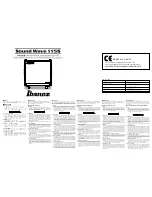
12
Ground Loops
Almost all cases of noise can be traced directly to ground loops, grounding or
lack thereof. It is important to understand the mechanism that causes ground-
ing noise in order to effectively eliminate it. Each component of a sound
system produces its own ground internally. This ground is usually called the
audio
signal
ground. Connecting devices together with the interconnect-
ing cables can tie the signal grounds of the two units together in one place
through the conductors in the cable. Ground loops occur when the grounds of
the two units are also tied together in another place: via the third wire in the
line cord, by tying the metal chassis together through the rack rails, etc. These
situations create a circuit through which current may flow in a closed “loop”
from one unit’s ground out to a second unit and back to the first. It is not sim-
ply the presence of this current that creates the hum—it is when this current
flows through a unit’s audio signal ground that creates the hum. In fact, even
without a ground loop, a little noise current always flows through every inter-
connecting cable (i.e., it is impossible to eliminate these currents entirely). The
mere presence of this ground loop current is no cause for alarm if your system
uses properly implemented and
completely
balanced interconnects, which are
excellent at rejecting ground loop and other noise currents. Balanced intercon-
nect was developed to be immune to these noise currents, which can never be
entirely eliminated. What makes a ground loop current annoying is when the
audio signal is affected. Unfortunately, many manufacturers of balanced au-
dio equipment design the internal grounding system improperly, thus creating
balanced equipment that is not immune to the cabling’s noise currents. This is
one reason for the bad reputation sometimes given to balanced interconnect.
A second reason for balanced interconnect’s bad reputation comes from
those who think connecting unbalanced equipment into “superior” balanced
equipment should improve things. Sorry. Balanced interconnect is not compat-
ible with unbalanced. The small physical nature and short cable runs of com-
pletely unbalanced systems (home audio) also contain these ground loop noise
currents. However, the currents in unbalanced systems never get large enough to
affect the audio to the point where it is a nuisance. Mixing balanced and unbal-
anced equipment, however, is an entirely different story, since balanced and
unbalanced interconnect are truly
not compatible
. The rest of this note shows
several recommended implementations for all of these interconnection schemes.
The potential or voltage which pushes these noise currents through the
circuit is developed between the independent grounds of the two or more units
in the system. The impedance of this circuit is low, and even though the voltage
is low, the current is high, thanks to Mr. Ohm, without whose help we wouldn’t
have these problems. It would take a very high resolution ohm meter to measure
the impedance of the steel chassis or the rack rails. We’re talking thousandths
of an ohm. So trying to measure this stuff won’t necessarily help you. We just
thought we’d warn you.












































